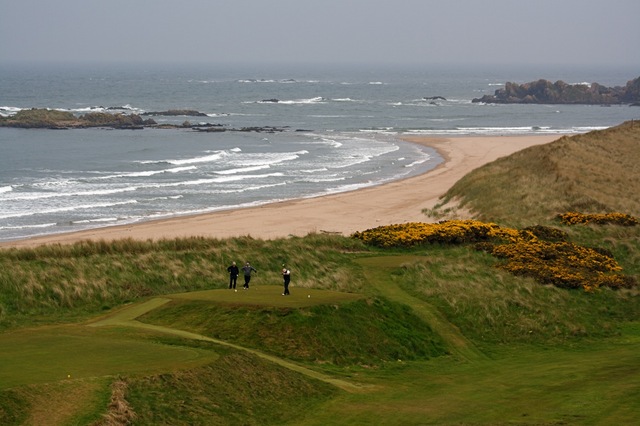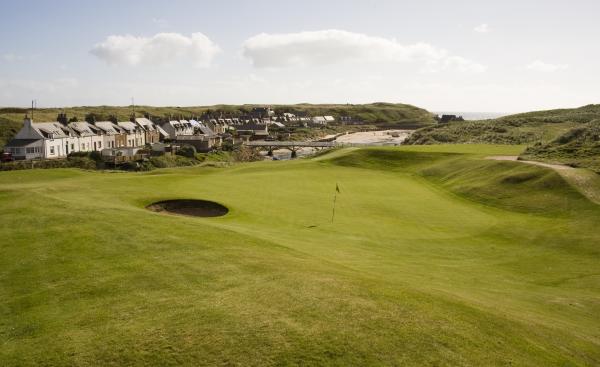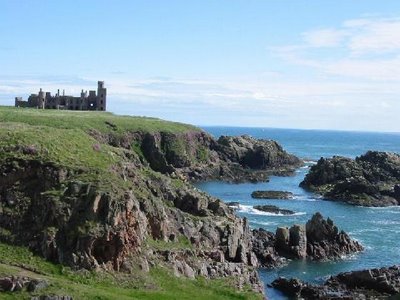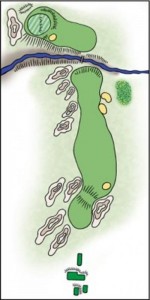Cruden Bay Golf Club can boast so many interesting tales before beginning to touch on talking about this stunning Scottish golfing gem.
The course, located on the north-east Scottish coastline, is laid out on the site of 1012 Battle of Cruden.
Perched high on a cliff top overlooking the course is the ruins of a 16th Century castle that is believed helped inspire Bram Stoker to write his famed novel, Dracula.
And there’s one hole at Cruden Bay, the par five sixth, that has been likened to renowned American singer Dolly Parton though I will allow you to work out why for your good self.
However aside from the battle, the ruins, the famed author and the well-endowed musician, Cruden Bay is a foremost a golfing wonder piece.
Cruden Bay is located about 30 kilometres north of Aberdeen in Scotland and laid out along the shoreline of the Bay of Cruden.
It’s a wild, rugged yet manicured links gem. It’s not too punishing and it makes the pilgrimage of discovering this piece of Scotland worth the visit.
I first played Cruden Bay in the mid-90s and shortly after the now defunct Dunhill Cup at St. Andrews.
It was October and the sun rose around 9am and it got dark about 3.30pm.
I remember it being so cold during the later stages of my round that it began to hail. The hail was about the size of the head of a match and it stung my face and hands.
The wind was also blowing hard and in playing a 5-wood shot at one hole on the back nine, my golf ball ballooned into the air and flew back over my head landing some yards behind me.
As well, my hands were becoming so cold I could not get them into my pockets, and I left the course with still two or three holes to play.
That was my introduction to Cruden Bay.
I recently returned to Cruden Bay but this time in summer and also armed with more information about this unique slice of Scotland golf.
Next month, Cruden Bay celebrates the millennial anniversary of the 1012 Battle of Cruden when Scots King Malcolm 11 and his soldiers defeated a ferocious Viking army led by Canute who would later become King of Norway, Denmark and England.
The bloody battle was fought over ground where the golf course now stands and hence the name of the ‘Bluidy Burn’ as it’s believed the stream ran red with the blood of Scots and Vikings.
The Viking invasion 1,000 years ago proved to be the high water mark of Scandinavian aggression and it secured Scotland, the Northern Isles and Outer Hebrides in Scotland’s favour.
A modern Cruden Bay clubhouse stands now like a sentinel overlooking the former battle ground.
On this second visit we drove up the clubhouse in bright sunshine so much looking forward to tackling this wonderful links course but also, in the back our minds, wondering how we would play ‘Dolly’s Hole’.
The Club itself was founded in 1791 when members began playing golf over a course at nearby Port Errol.
It wasn’t to more than a century later a new course, designed by Old Tom Morris , with help from Archie Simpson, was opened at the foot of cliff on top of which the Cruden Bay Hotel has been built in 1896 by the Great North of Scotland Railway Company.
The magnificent hotel, said in its days to have rivalled Turnberry and Gleneagles, was built of pink Peterhead granite and attracted wealthy golfers to travel north on the railway from Aberdeen.
The army took over the hotel but when the war ended the hotel never again opened, and in 1947 was sadly demolished.
Fortunately, a syndicate of interested persons from the British Transport Commission got themselves together and purchased the golf course thus ensuring its continuation to this day.
The course opening was celebrated with an inaugural professional two-day tournament on 14-15 April, 1899, with prizes totally £120.
The great Harry Vardon, who won two of his five Open Championship’s in 1898 and 1899, led by a stroke after the first day’s play. Also in the field was Simpson, runner-up in the 1885 Open along with Andrew Kirkaldy, a double Open second place finisher in 1878 and 1891, plus legendary James Braid who was go on to win four Open Championships (1901, 1905, 1906 and 1908).
Vardon prevailed on day two defeating then 22-year old Prestwick St. Nicholas professional, James Kinnell.
Of interest, Kinnell later turned his hand to club making and was the ‘J’ in ‘D and J Kinnell’ of Prestwick. A club in Pennsylvania offered Kinnell a large sum to be their club professional but he declined and, instead joined the British Army to fight in the First World War.
Sadly, he killed in battle in the first year of the war, 1914.
Cruden Bay measures 6,395 yards off the white tees, 6,022 yards off the yellow and 5,761 from the Ladies tees.
It’s a golf course where you don’t have to hit Bubba Watson-like booming drives. Just keep the ball in play, make a few putts here and there and irrespective of your handicap you should score because, above all else, this is a member’s course and it recognises all too well that most golfers don’t get a whole lot of fun playing par fours of near 480 yards.
In fact, the longest par four at Cruden Bay is the 454-yards off the white and 10 yards shorter from the yellow.
The fifth also is the only par four over 400 yards. The shortest of the par fours is the 286-yard third hole and the 258-yard eighth.
The course opens with Slains, a 416-yard par four rated the seventh hardest. The hole is named after the 16th century Slains Castle perched on a cliff top overlooking the course. It was the home of 7th Earl of Erroll and overlooks Port Erroll and the course.
In the late 19th Century, the 19th Earl of Erroll used the castle to entertain many of his friends. Bram Stoker once stayed at a Cruden Bay hotel with his wife and is believed was so inspired by the Castle he saw it as ‘the castle of the dead’ and helped inspire his writing of the infamous novel, Dracula.
The castle was sold in 1916 but fell into disrepair, after more than 300 years of occupation by the Erroll’s. The castle was bought by Sir John Ellerman of the shipping line game but he turn gave it up in 1925 and had its roof was removed to avoid paying taxes. That led to the inevitable ruin seen today.
The Cruden Bay Golf Club was formed around 1900 with the first Captain being the Rev. B. Alcock.
In 1926 the club employed Tom Simpson and Herbert Fowler to redesign the layout and at the same time they redesigned the St. Olaf course.
The onset of World War 11 sent doubt into many golf clubs not only at Cruden Bay but all along the coast of Scotland including the magnificent Crail course in Fife where to this day there is still standing close by the control tower and runways from HMS Jackdaw.
Cruden Bay like all courses rewards thought, placement and precision. Two of the more memorable holes, for entirely different reasons, are the par five sixth and the par four 10th.
The par five sixth, and fifth hardest on the course, measures 529-yards off white tees and here’s where I was reminded of Dolly Parton.
It has to be the most colourful description of any hole I’ve ever played in more than three decades reporting on golf.
You then need to play your second shot so that it lands in the vicinity of Dolly’s left foot and short of the Bluidy Burn guarding the green. From there it’s a chip shot to an uphill green.
I’ve never since read or heard of a hole described in such a manner.
While Dolly Parton remains one of the icons of music so too Cruden Bay continues to be a golfing icon.
The 385-yard 10th is named Scaurs and it is another standout hole, if simply for the magnificent views afforded across Cruden Bay from the tee.
It’s difficult, apart from say the seventh at Ballybunion, or perhaps the sixth at Royal Portrush, to single a more attractive place in golf that invites the golfer to drive the ball from the tee. The drop from tee to fairway is all of 100 feet, whilst the hole at 385-yards is not long but you still have to exercise caution with your second shot, as it split close to the green by a burn.
The closing eight holes contain a number of fascinating challenges, none more so than the par three, 239-yard 15th hole named Blin’ Dunt. You stand in the tee needing to thread your ball through the eye of a needle, a tall order for most but a hole which helps set Cruden Bay apart from so many other courses.
There’s novel bell system running nearly the length of the hole that when you have putted out you tug on a 150-yard long rope that rings a bell back up the fairway.
Some years back the architect Donald Steel was called to cast his eye over Cruden Bay amid fears the course no longer afforded a challenge to modern golf equipment.
He quite rightly stated that, while many of the holes are eccentric, it was Cruden Bay’s very eccentricity that gave the course its essence and character.
Steel wisely refrained from tinkering for its own sake and instead simply added a few fairway bunkers to keep the longer hitters honest.
Pete Dye also visited Cruden Bay describing the course ‘outsized, non-conformist, unpredictable, flamboyant.’
Now is that not what links golf is all about?









